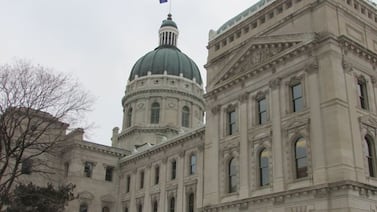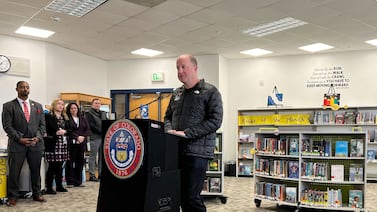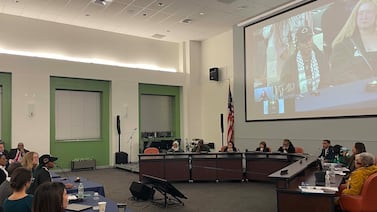Sign up for Chalkbeat Newark’s free newsletter to get the latest news about the city’s public school system delivered to your inbox.
Middle schoolers in Newark Public Schools are attending classes in overcrowded buildings that fall short of state space requirements, a new report from the New Jersey Department of Education finds.
Newark, New Jersey’s largest school district, does not have a dedicated middle school and enrolls grades 6-8 in elementary and high schools across the district. The district’s enrollment has increased in recent years, pointing to its need for more school space.
The report highlighted Newark’s ongoing need to replace its public schools, some of which date back to the 1920s and are among the oldest in the state. The report also found that roughly two-thirds of high-poverty districts — formerly known as Abbott districts — do not have enough space to meet student needs, underscoring other existing infrastructure problems such as inadequate HVAC systems and outdated school buildings.
Newark faces significant facilities challenges due to its crumbling school buildings and a lack of funding from the state. The district has identified 33 out of its 64 total schools that need replacing and dozens more that need renovations.
The state’s Schools Development Authority, or SDA, is required to pay for construction projects in Newark and 30 other high-poverty districts. Despite efforts to address these challenges in Newark, including the allocation of $18 million in state funding for building upgrades over the last three fiscal years, the district estimates that it would need more than $2 billion to repair and update all schools.
The new report “speaks to the ongoing need to continually assess school facilities” and fund construction projects, said Theresa Luhm, an attorney and managing director at Education Law Center, a nonprofit that works to protect the rights of public school students.
“I would argue it’s also for the SDA to have some kind of consistent funding stream so they can make plans as they go. Right now, it doesn’t matter what needs they identify because there’s no money to fund projects in the long run,” Luhm said.
Studies show that investing in school facilities, and new school construction in particular, can improve K-12 student outcomes, particularly for students from low-income backgrounds. A report from the Annenberg Institute at Brown University found that after three years in a new school building, student attendance improves by “a statistically significant but small one percentage point” annually.
Luhm added that overcrowding can also cause schools to sacrifice specialized spaces to make room for classrooms.
“So now you’ve taken away your science labs or art, music rooms, or other areas because now you’re just using that as regular classroom space,” Luhm added.
Newark among 31 school districts with urgent repair needs
Required every five years to help the SDA prioritize school construction projects, the new report found that 19 of the 31 SDA districts have capacity deficiencies or provide fewer square feet per student than mandated in the New Jersey Facilities Efficiency Standards, which set minimum square footage to support learning.
Newark Public Schools’ buildings serving grades 6-8 are over capacity, and provide less space per student than required, according to the report. The district does not have a school dedicated solely to middle school grades. Of the district’s 64 schools, 36 enroll students in pre-K-8, three enroll K-8, two high schools enroll grades 7-12, one enrolls K-6, and another enrolls pre-K-7, according to the district’s school directory.
Newark’s neighboring city Elizabeth faces the most severe overcrowding and space shortages across all grade levels, the state report says. Bridgeton, Garfield, Irvington, New Brunswick, Orange, and Union City face overcrowding and inadequate space in at least one grade span. Paterson, Perth Amboy, Plainfield, West New York, Union City, and Vineland rank among the districts with the lowest square footage per student.
To fix the problems in these and other districts, the SDA needs more money. Over the last three fiscal years, New Jersey has allocated $2 billion for school construction projects, but that money has already been committed to emergency projects, leaving no money for new projects, according to Sen. Vin Gopal (D-Monmouth) earlier this year.
It currently receives funds from the legislature on a “pay as you go” basis with no long-term funding to support their work.
Last year, Newark Public Schools was weighing whether to present a $1.2 billion bond referendum to city voters this April to cover school repairs. But district leaders squashed that plan after learning that it was unlikely to gain support, Superintendent Roger León said earlier this year.
Luhm and others have called on state leaders to provide more funding. The Healthy Schools Now coalition, which represents more than 100 organizations across the state, is also calling on Gov. Phil Murphy and the legislature to provide $500 million annually to the SDA, starting with the upcoming budget, which must be finalized by June 30.
The SDA last summer promised to replace 13 of Newark’s oldest buildings, but the deal still leaves out 20 schools that need replacements. The state agency also said it would spend nearly $153 million to build a new University High School and relocate Hawthorne Avenue Elementary School, but the plan is still in its early stages.
Since 2006, only nine new schools have been built in the district; one other property was given to Newark by the state to open the Nelson Mandela Elementary School. And since 2016, district officials have asked the SDA to fix more than 100 buildings.
Jessie Gómez is a reporter for Chalkbeat Newark, covering public education in the city. Contact Jessie at jgomez@chalkbeat.org.




